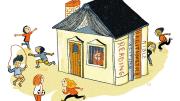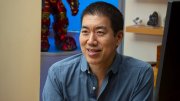When Andrea Baccarelli stepped into his role as dean of the T.H. Chan School of Public Health in January 2024, he could hardly have foreseen the financial headwinds that would soon batter one of the world’s leading public health institutions. A sudden shift in federal research funding—long the bedrock of the school’s budget—has forced painful choices and urgent innovation. But Baccarelli said in a June interview that within this crisis lies an opportunity: to remake the school as an even more resilient, impactful institution.
Of all Harvard’s schools, none was as vulnerable to the Trump administration’s cuts to research funding as the Chan School, whose work has helped improve the health of millions. Roughly 47 percent of the school’s revenue came directly from federal sources. An added endowment tax and threats to international student enrollment compounded the blow for a school where global reach has always been a point of pride. “We lost, overnight, $200 million,” Baccarelli said. “Unfortunately we have had layoffs, and we will have more.”
“We are no longer thinking about how we save the school, but how we plan for the Chan School of 2030.”
Baccarelli’s first instinct was to protect the school as it was, attempting to preserve every program and maintain the status quo. But he quickly realized the futility of that approach, given the immensity of the potential financial losses. “At some point, we pivoted from grieving the past to planning the future,” he said. At a Commencement event, a faculty member reminded him that resilience and entrepreneurial spirit run deep in the school’s DNA—faculty typically secure about 65 percent of their own salaries through external funding.
“If there is a group of people who can pivot,” Baccarelli reflected, “it’s us. So, I changed the message and decided that we are no longer thinking about how we save the school, but how do we plan for the Chan School of 2030? The vision I have is a school of the highest quality, probably smaller in size.”
This recognition shaped a new vision: the school won’t pursue growth for its own sake. “Academia,” Baccarelli said, “is often about growing, but growing is not a virtue…I think we are moving [to become] a school that doesn’t want to grow in size any longer, but wants to grow in quality, excellence, and impact.”
Layoffs of research staff whose federal funding had been canceled began in April and now extend to administrative roles. Offers of admission to incoming Ph.D. students have been cut by about half—an almost unthinkable step for a school long committed to supporting doctoral education with generous, multiyear funding contributions. The school will continue to support existing Ph.D. students—whose education spans five years at an annual cost of about $100,000 per person—for the remainder of their studies.
The loss of federal grants remains the biggest challenge, in terms of both money and mission. “To conduct so much research commissioned and sponsored by the government,” said Baccarelli, “was a point of pride.” And because such contracts were awarded by panels of the nation’s leading scientists, “[w]e used the success of colleagues in securing NIH grants to evaluate faculty for promotion. But this system can’t stay the same.”
Faculty are pivoting to corporate partnerships. Already, 14 percent of operating revenue in fiscal year 2024 (July 1, 2023 - June 30, 2024) came from corporate-sponsored research. A $30 million collaboration with biotech firm Enlila on diabetes and aging was announced in June. Because corporations aren’t driven by an interest in basic science, but instead by avenues of research that could lead to commercially viable products, a substantial challenge of the shift toward corporate-sponsored research will be developing new, objective means of assessing the quality and importance of faculty research.
“We will need to manage conflicts of interest,” Baccarelli acknowledged. “But we always have.” He notes that even government funding can subtly shape institutional priorities. To guard against undue influence, he plans to standardize how the school measures quality, ensuring research rigor and transparency, and to strengthen the evaluation of instructors across departments.
On the educational front, the crisis has accelerated innovation. While core doctoral programs depend on the school’s operating budget, master’s and executive education programs have been self-sustaining—an advantage now. The school plans to expand both its existing online master’s degree programs—in part to reach international students if they cannot attend in person—as well as its in-person nondegree and customized executive education initiatives for working professionals and organizations such as the U.S. Navy.
Demographic trends, though, are a challenge: with fewer American students pursuing graduate education in public health, international students, who made up 42 percent of the student body last year, remain vital. These students often return home to become prime ministers, secretaries of public health, or leaders of national programs, extending the school’s influence globally.
Longtime donors have stepped up with $3.5 million in additional gifts, but Baccarelli knows philanthropy alone can’t fill the gap. “What we’re doing now is not about saving the school,” he said. “It’s about building a better version of it.” Encouragingly, the crisis has inspired a shift in culture: a recent finance group report called for more transparency and accountability, and faculty and staff are more engaged in understanding the school’s financial realities than ever before.
Through painful cuts and bold pivots, the Chan School is reinventing itself—smaller but more focused, less dependent on a single funding source, and more attuned to the real-world impact of its work. For Baccarelli, the upheaval clarifies the mission: “Easy, quick, and cheap—that is the kind of solution that can help millions of people.” It’s a tall order, but he is convinced the crisis will transform the school into a more potent force for global public health.








